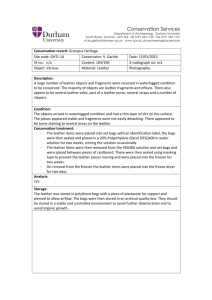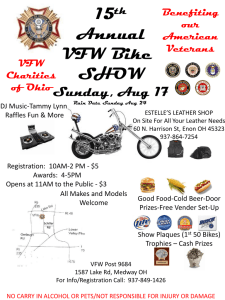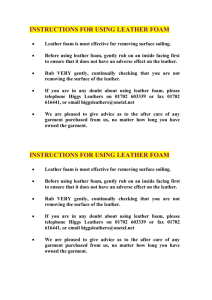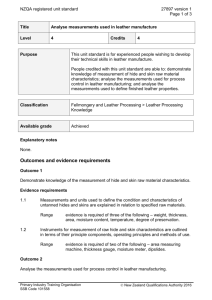Leather and Islam in Iberian Peninsula
advertisement
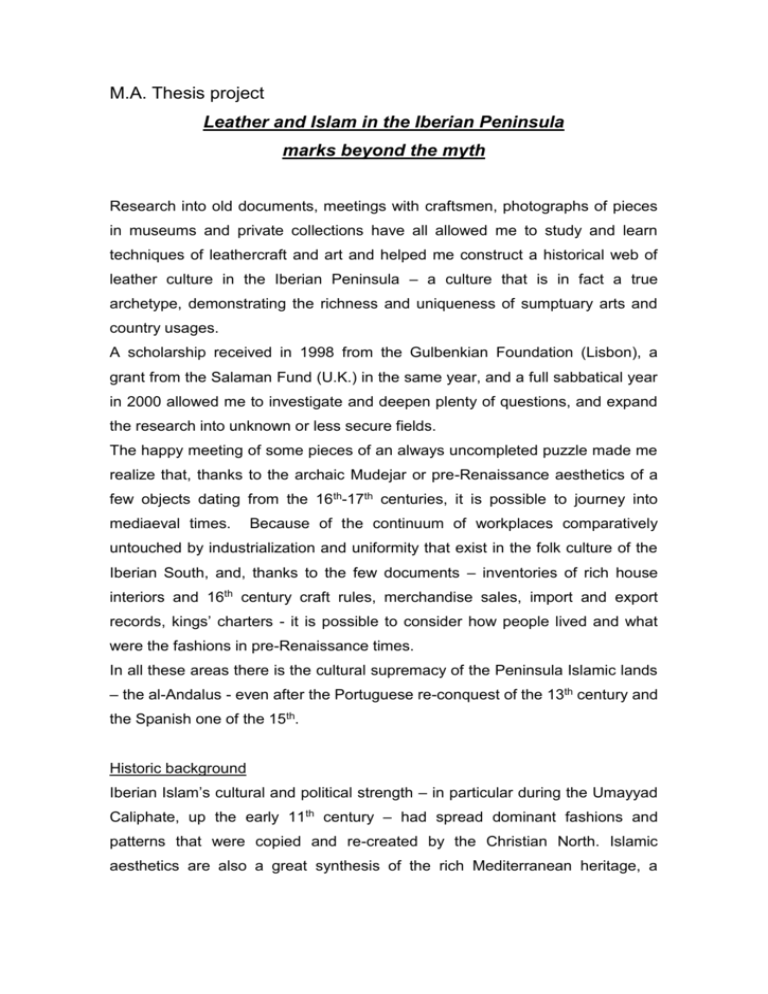
M.A. Thesis project Leather and Islam in the Iberian Peninsula marks beyond the myth Research into old documents, meetings with craftsmen, photographs of pieces in museums and private collections have all allowed me to study and learn techniques of leathercraft and art and helped me construct a historical web of leather culture in the Iberian Peninsula – a culture that is in fact a true archetype, demonstrating the richness and uniqueness of sumptuary arts and country usages. A scholarship received in 1998 from the Gulbenkian Foundation (Lisbon), a grant from the Salaman Fund (U.K.) in the same year, and a full sabbatical year in 2000 allowed me to investigate and deepen plenty of questions, and expand the research into unknown or less secure fields. The happy meeting of some pieces of an always uncompleted puzzle made me realize that, thanks to the archaic Mudejar or pre-Renaissance aesthetics of a few objects dating from the 16th-17th centuries, it is possible to journey into mediaeval times. Because of the continuum of workplaces comparatively untouched by industrialization and uniformity that exist in the folk culture of the Iberian South, and, thanks to the few documents – inventories of rich house interiors and 16th century craft rules, merchandise sales, import and export records, kings’ charters - it is possible to consider how people lived and what were the fashions in pre-Renaissance times. In all these areas there is the cultural supremacy of the Peninsula Islamic lands – the al-Andalus - even after the Portuguese re-conquest of the 13th century and the Spanish one of the 15th. Historic background Iberian Islam’s cultural and political strength – in particular during the Umayyad Caliphate, up the early 11th century – had spread dominant fashions and patterns that were copied and re-created by the Christian North. Islamic aesthetics are also a great synthesis of the rich Mediterranean heritage, a melting of Sasanian, Coptic, Byzantine and Latin legacies, plus the ones found in Iberia, of Roman and Visigothic times. Besides the political elite, whose forerunners were the Umayyad court in Damascus, living in the al-Andalus cities, Iberia received the influx of North Africa Berber tribes; besides their service in the armies, they kept on their life of farmers and shepherds on the southern plains. In parallel with the court aesthetics was the rural production, both stressing, in what is simply called “decoration”, the sense of belonging to a culture and to a faith. Due to hunting and herding, leather was a very common raw material for many indispensable trades. The Portuguese Re-conquest, with the signature of treaties or simply looting Islamic cities and turning inhabitants to slavery, or keeping them working in the crafts or as farmers, did not change the know-how rooted in tradition, concerning fashion, how to sit, to ride, in the putting-up of wall hangings, or concerning footwear, shields, saddles, cushions, and so on. Between the 12 th and early 17th centuries, the several kings’ forals, trades’ rules and palaces’ inventories are clear enough in showing the legacy of Islam, and, therefore, in the keeping-up of the same type of handiwork and ancient patterns in craftsmen products. Leather’s degradeability, its common use for daily and utilitarian purposes, and the dominant oral tradition are rather significant problems for a complete understanding of its importance. Nevertheless, the available visual and written data, and the following discoveries, need a lot of attention in the uncovering of a cultural heritage so many times forgotten by the mainstream of History and Art. Multiculturalism, pedagogy, anti-cultural colonialism This is a project aimed in studying a forgotten trend, ignored or thrown out of mainstream art, considered of low artistic interest and weak social status (besides its weak economic value). There is a need to take into account the aesthetics of manufacture outside the ones praised by Western dominant thought, to give them value and even re-establish them while questioning the artistic hierarchy and separation between the craft-made and the court-made. This is a hidden stream of research : it aims at studying the legacy and culture of the ones who lost the battle; it looks to study the material culture of shepherds and farmers; it looks at carved leather chairs beyond their easy labeled wooden structure; it includes the productions of several extinct craftsmen guilds whose names are nowadays hardly known; it considers antique pieces, like tapestries, bookbinding, ceramics, stone sculpture, frescos, ivories, paintings and jewelry as bridges for understanding the few antique leather pieces and early Renaissance leather artifacts; it considers the actual production of the marginal societies of the southern Iberian plains (the ones facing extinction due to the quick social and economical changes); it looks to put aside prejudice and labels concerning the uses of a highly considered noble material like leather. It must also be stated that is not possible to actualize aesthetics and find contemporary visions and seductive uses for leather without knowing the history and techniques used, as has been happening with textiles, ceramics or stonework, for example. Regarding schoolwork, there’s also a need to find strategies based on curricula that express the diversity of world cultures and lifestyles, easing understanding between people from different ethnic origins and background. About the decisions laying at teachers’ hands, one of the aims of artistic pedagogy is to abandon the misunderstanding and prejudice facing non-European cultures that are present in school and society. I find one of my themes in the UNESCO “Art & Society” congress, back in 1999. “What is multicultural art education?”, asked Rachel Mason then. One of the ways is to take care of popular traditions faceto-face the dominant patterns and fashions, that act as a cultural colonialism; and I quote: “the majority of contributors agree that, in practice, present curricula tend to be mono-cultural and are dominated by a western (modernist) fine art canon” As an answer there’s the study of different aesthetic practices without quality hierarchy. Another theme for this project is the safeguarding of national and regional identities. The fast changes in the last years take traditional manufactures near to extinction (many are already gone); working rhythms of societies that do not have decision power nor lobbies in the state, that keep on having low development and scarce support from central government, are all on the extinction list. Crafts and small country industries tend to be sanctuaries to safeguard memories, that are to be rescued from the machines of pseudo- cultural propaganda. As in Nature, the extinction of species means the power of a monoculture. The dominant ideology is ruled by the possibility of economic worth, turning everything to a merchandise – but memory, techniques, ways of life and identity can hardly be exchanged for a pack of notes. The recent armed conflicts, given emphasis since the terrorist attack on September 11th 2001, have also stressed a growing urgency in understanding the Other. Revenge, violence and prejudice should be fought with culture and education, particularly when both these fields have so many influences brought or recreated by centuries of Muslim living in Iberia. In the last 10 years many books have been published in Portugal, concerning archeology, Middle Ages, Islamic heritage or 16th century paintings. They all omit leather studies, whether considering daily artifacts or the gilt leather wall hangings pictured in Renaissance paintings. Recently, both Spain and France published catalogues of magnificent exhibitions on the Muslim legacy left in the lands that the Re-conquest turned into Spain and Portugal. Besides the wealth and prestige of cities as Seville, Cordoba, Grenade or Toledo, one must consider Évora, Silves and Lisbon. Besides the rich publications of the “Legado Andalusí” Foundation in Spain, there’s still a void regarding leathercraft and art, whether of Berber or Umayyad influences. Considering historic leatherwork in general, very little has been published. In libraries in Portugal and Spain I have found some studies on bookbinding, tanning and shoemaking in Morocco, and that was it; there’s plenty on lusterware, pottery, metal, textile or archeological findings. But a little pattern carved in a leather seat dating late 16th century in Portugal, or a similar one in a gilt leather altar front in Spain, in a Coptic textile of the 3 rd century, in a Jordan palace stucco of the 8th century, in a pottery bowl of Persia of the 13 th century, in a bookbinding of North Africa of the 9th century, or in a wooden stamp for homemade cakes of the 1950s in Portugal, can make one wonder and envision a web of aesthetics, trade, travel, bridges between materials and craftsmen – this is an exercise of the pleasure of learning and research, truly needed when one knows that very few leather pieces have survived the centuries of use and dispose of. My meetings or letter exchanges with some scholars of archeology and art history emphasize the need to research in an unknown field where few and correct studies do exist. “Leather and Islam in the Iberian Peninsula”, as a thesis project – and future publication, I hope - has, as a general aim, to clear up the heritage left in Iberian culture by a rich civilization, artistically brilliant and, to a great extent, multicultural and tolerant (at least up to the dominant North Africa dynasties of the Almoravids and Almohads). I add the subtitle “Marks beyond the myth” to reinforce one of the research objectives: to put aside easy commonplaces pretending to be facts – like the identification between the al-Andalus with Spain, labeled as Islamic, the use of “Cordoba leather” as a label for all seasons, calling “cordoban” any ancient leather piece, and “embossed” any technique besides gilding. In spite of the two catalogues published by the Leather Art Museum in Vic (Spain) in 1992 and 1998, there’s still the fame of the “Cordoba leather” produced during Islamic times. One must stress that much of such fame is nothing but a myth, made up with negative nationalistic ideas. With the studies on early Portuguese leather carved chairs (16 th-17th centuries) and on rural artifacts, it’s possible to find clears trends of patterns and production areas that kept on even when the Gharb (Occident) al-Andalus became Portuguese in the 13th century – which means they were still used four centuries after Portugal geographically becoming what it is nowadays; and that popular patterns turned marginal and still survive in a rural culture. Methodology The project will continue through the direct contact with craftsmen, the findings in country fairs and museums, the study of old documents, the drawing of tools, patterns and models, and making use of computer capabilities to turn small details into clear patterns. Franklin Pereira (frankleather@yahoo.com) University of Minho Braga, Portugal
